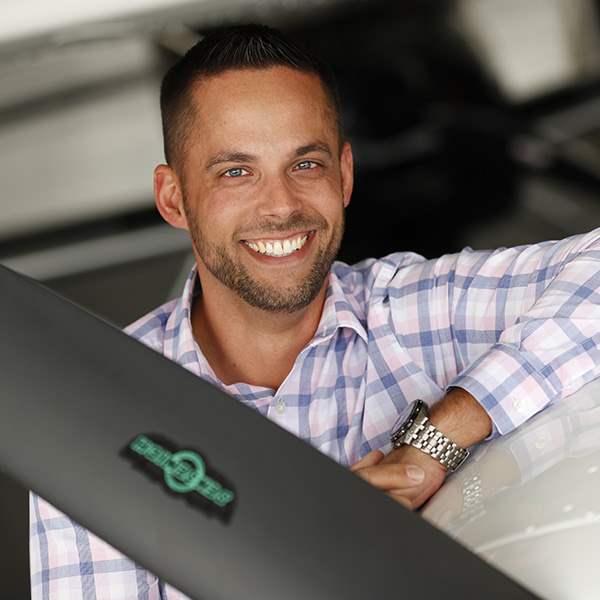Stretching my legs in a Super Cub
One pilot's highway from the comfort zone
The ferry flight from Florida would never be any kind of historic milestone. Lots of pilots have made more difficult journeys in much more valuable airplanes; I wasn’t special. But doing it for the first time in AOPA Air Safety Institute Senior Vice President (and former U.S. Air Force Thunderbirds lead pilot) Richard McSpadden’s Piper Super Cub wasn’t any less terrifying for me.
McSpadden trusted AOPA Publications Content Producer Alicia Herron with a similar trip not long ago. I should mention that Herron is a CFI, and has way more hours than I do. Choosing her for a ferry flight was a no-brainer, but choosing me? I’d never flown far enough to need a fuel stop, I only had 34 tailwheel hours, and only 28 of those were in a Super Cub.
Turned out, he was.
I assured my wife that I'd only need a couple of days “on the road,” enough time to catch an airline flight from Maryland to Florida, hop in the Super Cub, and fly it back. That sounded reasonable and the weather seemed like it would cooperate.
Considering this a once-in-a-lifetime opportunity, I nervously agreed to ferry the Super Cub.

This was quite a bit beyond the flight planning I had done before, and I had to expect the possibility of delay along the way. How would I pack? What should I eat and drink on a trip like this? What about tools? Survival gear? First aid? I’d worry about that later.
I started planning a beeline for home to avoid all the alphabet airspace, with some altitude changes and minor course changes because I didn’t feel like doing all that extra work. Proud of my clever plan, I showed McSpadden.
“Boring! Fly the coast, 1,000 feet offshore and 500 to 1,000 feet high,” he said. “But there are nine Class Deltas and a Class Charlie to deal with,” I complained to myself. I’d deal with it later, like everything else.
I asked around about snacks and drinks. AOPA Digital Media Senior Director Alyssa Cobb suggested grapes and clementines to stay hydrated (and put a little food in my stomach). Nuts are a good source of protein to help stay alert. And sports drinks were another top mention to replenish electrolytes. Trail mix, granola bars, sports drinks, water, and grapes it was. Food was handled.
Maryland was windy with temps in the 30s Fahrenheit, while Florida was hitting 80 degrees Fahrenheit. T-shirts, jeans, shorts, loads of socks and underwear, and a light jacket. Toiletries. Phone, kneeboard, iPad, battery packs, headset, headlamp, sunglasses. I wouldn’t even need to check a bag. Packing was done.
Off to ‘sunny’ Florida
One comparatively boring airline flight later, I showed up at the home where McSpadden was staying in Florida with a gentleman named Jeff Davis (a guy to whom I owe a debt of gratitude for his hospitality and generosity—more on that later). I introduced myself, and we all had some pleasant conversation, then got down to talking flight plans and weather.
Having resigned to following the coastal route McSpadden suggested, I was going to leave at 6:30 a.m., fly three-quarters of the way home on day one, and have a leisurely two-hour final leg on day two.
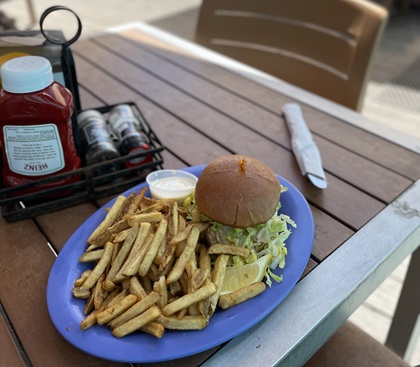
Yet that once-beautiful forecast had changed. North Florida was going to be IFR with a couple areas of marginal VFR. Visibility and ceilings would be low. I sheepishly informed my wife I’d be getting home later than expected. She married a pilot, so she already knew things wouldn’t go as planned.
The next day, I grabbed my laptop and set myself up outside to work from my temporary southern Florida office. I had no sooner sat down than in walked McSpadden:
“I have an idea for you.”
“Uh oh,” I thought.
He suggested that since weather up north was garbage, why don't I fly south to Key West and grab lunch? The Cub was gassed up and it was about a 2.5-hour flight each way.
I considered the merits of adding a five-hour round trip to an itinerary that was already halfway out the window. The Florida Keys are legendary, and I might never get the chance again.
"OK, I’ll do it!”
I’d stay offshore and fly along the coast 500 to 1,000 feet over the water and talk to all of the tower and approach controllers along the way—even busy Miami—just in case anything happened and I needed to put down in a hurry. I’d fly along the Keys, keeping dry land in easy reach in case of emergency. I had an aircraft medical kit, McSpadden’s survival vest packed full of survival gear, and a bunch of hand tools in case something came loose (other than a screw or two in my head).
Not as hard as I thought
So, what did I discover? Talking to the controllers in quick succession was no big deal. I’m familiar with Class D airspace; my home airport is the same. I’ve talked to Harrisburg, Pennsylvania, controllers while transiting their Class C airspace. I’ve talked to Roanoke Approach in Virginia and landed at that Class C airport. I’ve even talked to Class B controllers at Baltimore/Washington International Thurgood Marshall Airport and Washington Dulles International Airport.
I could do this. And I did do this.
I had GoPro cameras rolling, cellphone out snapping pictures, and me in the middle of all that, taking it all in. I was flying in unfamiliar territory, by myself, over water (albeit close to shore), and it was fun! The water was turquoise. I saw cargo ships, nuclear submarines, groups of partiers hanging out in knee-deep water beside their boats, and rays “flying” through the water. Even the controller at Pompano Beach Airpark remarked how jealous he was when he heard my aircraft type and destination. He declined my offer to stop in and take him along for the “dream” trip, though. Something about not wanting to leave his co-worker alone to handle all the work.
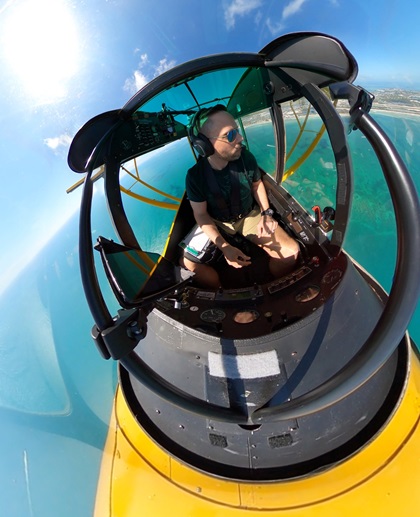
A few times I had to reel myself in. Scan engine instruments, double check that I wasn’t getting near airspace, look for traffic. Take a few specific pictures to promote some of AOPA’s products. Announce myself near The Florida Keys Marathon International Airport in case any of that traffic needed to know I was there.
I landed at Key West International Airport without incident. Signature Flight Support got the airplane parked and fueled and recommended Hurricane Hole for a quick lunch stop. I had to get back by 4:30 p.m. so McSpadden could take another friend up in the Cub, so I ate my mahimahi sandwich and forced myself to head back to the airport. By now, the commercial ramp was crawling with Boeing 737s and members of the Airbus 320 family, hundreds of passengers arriving and departing. The general aviation ramp was full of jets, pistons, and two gigantic turbine de Havilland Otters on floats loading up with sightseers.
The return flight was just as beautiful. I flew over the southern portion of the Everglades this time. While not as picturesque as the coast, it was a nice change of scenery. The one downside is that I was starting to get those afternoon pockets of turbulence thanks to the thermals. Passing North Miami Beach, one of them sent my phone tumbling out of the open window of the Cub, 800 feet down, and into the Atlantic (I had a two-handed grip and was holding the phone inside the cabin because I’m not stupid enough to drop a phone out of an airplane, or so I thought; reference those loose screws above). I had to continually remind myself to fly the airplane and be upset once I was safely on the ground. I’m still mad about it. (Jeff, thank you for letting me use your phone for navigation and your car to make the 50-minute drive to Palm Beach in rush hour to get myself a new phone, for the gourmet meals, and five-star accommodations!)
The next day, weather up north was worse than predicted. Pockets of IFR and MVFR persisted. Visibility was great, and Davis assured me the ceilings would improve within an hour or so. Just in case, I came up with a backup plan to turn inland once poor weather stopped my coastal journey northward. McSpadden liked it because I was always close to an airport and had lots of alternatives.

My plan to fly three, three-hour legs on day one was shot. I put plan C in motion and set off just after 10:30 a.m., 28 hours behind the optimistic schedule I had set for myself. The prediction about weather clearing along the coast proved accurate. There were some pockets of MVFR over land, but clear skies over the coast. I encountered low visibility and cloud cover near Daytona, but climbed to 3,000 feet, dialed up Daytona Approach, and got my clearance through the airspace flying VFR over the top (not to worry, I could see the clear skies a few miles ahead). One climb to 3,500 to avoid traffic, and in less than 10 minutes, the sky below was clear again and my ever-present headwind was less potent at that altitude.
Landing at Northeast Florida Regional Airport in St. Augustine was uneventful and provided the cheapest self-serve fuel I’d have on the trip at $4.79/gallon. Approaching Savannah, Georgia, I turned northbound over the wetlands and swamps and said goodbye to the coast. I had never seen so many planted forests and logging operations in such a wet location. Of course, living in the suburbs, I don’t really get to see many logging operations, anyway.
I planned to spend the night in Orangeburg, South Carolina. The airport had nice, manicured grass. It also featured new pavement, fresh markings, tiedowns with new ropes all coiled neatly around the anchors, self-serve fuel under $5 per gallon and an overnight tie-down fee of $6. The terminal building had a provision for after-hours access, and an honor system setup for refrigerated drinks. This was going to be a great place!
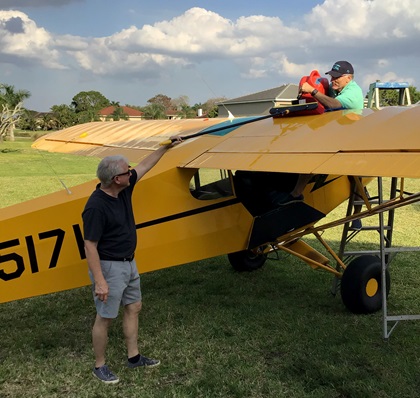
Not so ‘suite’ night
Reality didn’t live up to my expectations. The taxi service said a cab would arrive in 10 minutes. Forty-five minutes spent considering the ugly possibility of sleeping on the floor of the small terminal building, and another phone call later, a driver finally showed up. I had used ForeFlight’s “Info” tab to find a nearby hotel and the photos I found on a quick internet search looked good enough and had “inn & suites” in the name. As it turns out, it was a motel. I’m not that picky and I’ve stayed at motels before, so how bad could it be?
I prepaid for a “no refunds” room and signed a waiver promising not to have “visitors” over, play loud music, damage the room, or do illegal activities. Read between all of the lines in that last sentence. As I left the office to walk to my room, it was obvious the motel was undergoing renovations. Some of the rooms I passed were completely gutted, while others were partway through their refresh.
When I got to my room, I saw it was recently renovated…apparently by a teenager who was figuring things out as they went. It was also recently trashed by the room’s previous occupants. The single chair in the room and the comforter had mysterious dark stains on them, and the room smelled of cigarettes and “incense,” we’ll call it. There appeared to be a bloodstain on the shower wall, hair all over the bathroom floor, stained towels, and no toilet paper. Thankfully, the manager brought some up for me, escorted by an armed employee. I didn’t even attempt to open the mini fridge or microwave.
I didn’t see evidence of pests, but still made sure my skin never touched the floor. As I was starting to get myself settled, an “inebriated individual” came to my door that I thought was casing my room for robbery. McSpadden checked in to see how the flight had been and asked for pictures of the room, which I gladly shared. I imagined him laughing when he replied, “You’re getting the full Super Cub adventure. That hotel takes the prize.” I survived and got out of there as early as I could the following morning. I should have slept on the floor at the terminal.

Back at the airport, I started my preflight, checked the oil, sumped the fuel that I had pumped the evening before, paid my parking fees, and got out as quickly as the Super Cub would carry me. The next stop was a sleepy little airport in South Boston, Virginia. William M. Tuck Airport had a paved runway and a nice grass strip nearly perpendicular to (and crossing) the paved runway and taxiway. The winds favored the grass runway. I was in a Super Cub, so I went for it. The approach was over some tall trees on a hill with the runway starting at the bottom of the hill sloping back up.
The Cub was in its element, even if I was a little bit out of mine.
I found a terminal housed in a prefabricated trailer that reminded me of my early working days in construction, complete with a cozy lounge and 12-foot-by-12-foot restroom with a lonely toilet and sink occupying the vast space. I headed back to the grass runway to take off for my final leg to Frederick Municipal Airport in Maryland. This leg was bumpy (I had the windows closed this time to make sure my new phone stayed inside), but it meant I finally had a tailwind! My groundspeed hit 111 knots at one point. I traded farm fields, lakes, and logging operations for sprawling suburbs. Just one more landing and I could stretch my legs again.
Frederick wasn’t as busy as it usually is. I’d be able to land and go get my favorite meal from my favorite fast-food place that serves chicken Monday through Saturday! But the landing wasn’t good. At all. I got too slow and the airplane stopped flying about three feet above the runway. I added power to compensate, but it was too late. I bounced. I added full throttle and announced to the tower that I was going around. The controller tried to console me by saying it wasn’t the worst she’s ever seen. The next time around, I greased it. The controller keyed her mic and said, “November-Seven-Whiskey-Charlie, that one was beau-tee-ful. Taxi to park via Bravo, Charlie, monitor ground. Have a good one.” I was home.
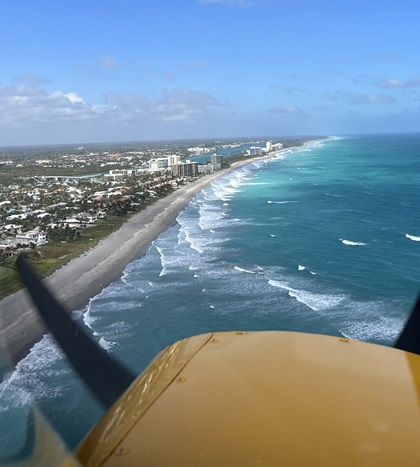
As I put the airplane away, I reflected on what I had just accomplished. In the last three days, I had flown by myself, most of it over water, and nearly all of it in unfamiliar territory. Aside from a lost phone and a sketchy night in a seedy motel, I had completed the trip despite doubting my abilities and McSpadden’s judgment.
The trip stretched my aeronautical abilities and decision making. I overcame get-home-itis to wait out bad weather. I changed plans on the fly. I flew over some of the most beautiful coastal areas in the country. I had to contend with distractions of all sorts. I traveled 1,271 nautical miles in 17 hours over three days and lost one phone, but gained some cool stories to tell.
As I was leaving, I got a congratulatory call from McSpadden; he had been checking my progress and wanted to see how the flight went. For some reason, this crazy guy was telling me things like “great job,” and that he felt his airplane was in safe hands. It meant a lot coming from a pilot of his caliber and experience. Good thing he didn’t see my first landing attempt at Frederick.
